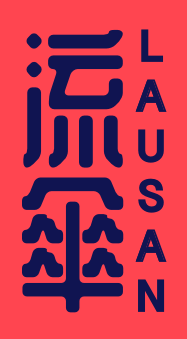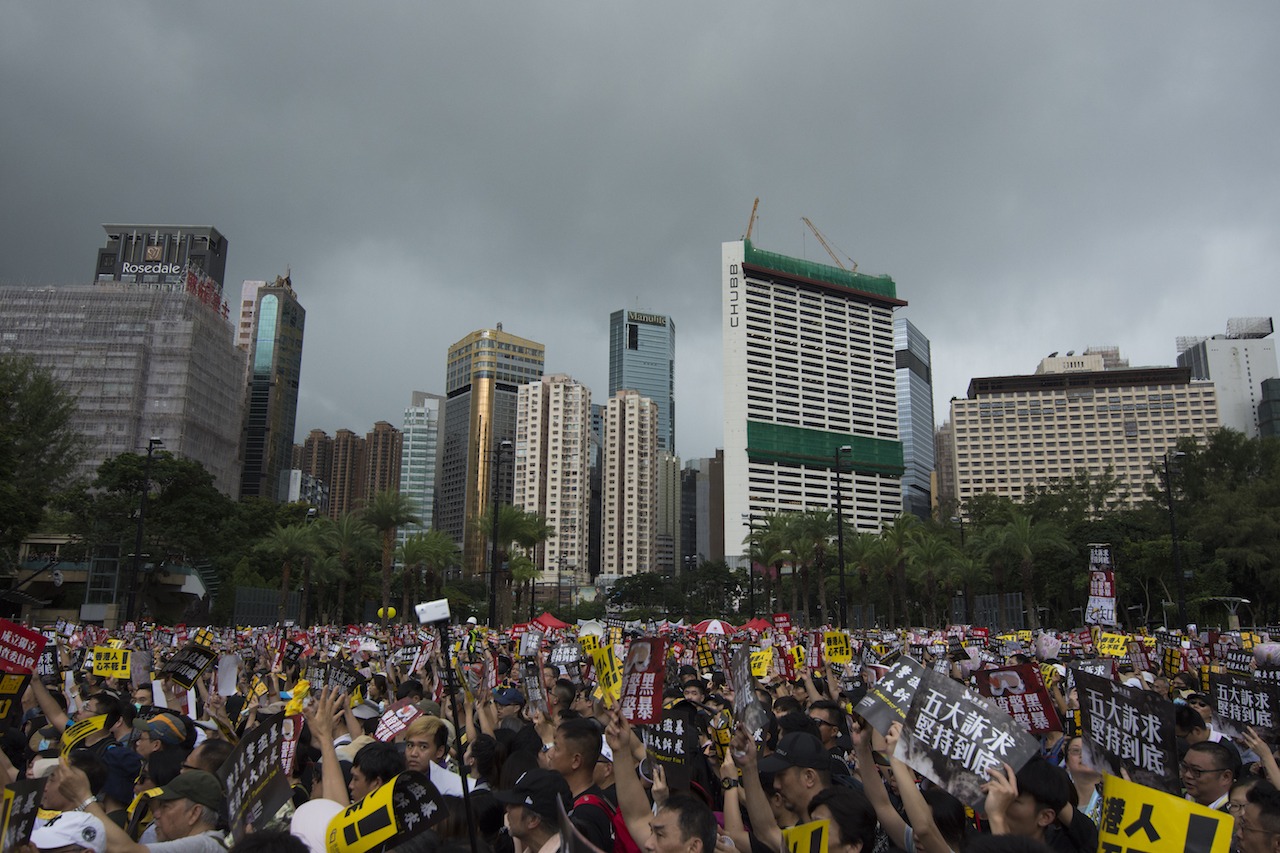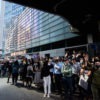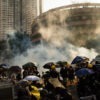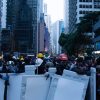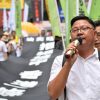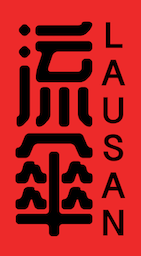Original: 【香港政治罷工史】, published in Reignite Press 懷火
Translators: Promise Li, Edward Hon-Sing Wong
If you would like to be involved in our translation work, please get in touch here.
Translators’ note: In early August, Hong Kong had its first general strike in over fifty years. Public discourse became filled with diverse opinions on what this strike would entail and what it would achieve. The author, Leung Po-lung, is a retired and disabled worker, who has been researching and writing on Hong Kong labor history with historians like Stanford University’s Chan Ming-kou, since the late 80s. In this essay, he gives a comprehensive introduction to the Hong Kong people’s experiences with political strikes since the British occupation of the city in 1842, in order to give better context to the August strike.
This essay touches on the lives and struggles of rich, but long-neglected, working-class lives in colonial-era Hong Kong, including rickshaw drivers, “chair coolies” and other coolie laborers, seamen, and dock workers. It recalls forgotten stories of the past, like how Hong Kong dock workers once conspired to blow up passing-by French vessels in support of the Vietnamese anti-colonial struggle in the late 19th century. More pertinently, this account reveals how many of these same colonial laws that were passed in response to workers’ struggles are direct precursors, if not the same ones, that are activated or called upon by the Hong Kong government today against its dissenters. Leung’s account of how the Emergency Regulations Ordinance was passed in the wake of the Seamen’s Strike, which paralyzed the city for weeks, in fact anticipates Carrie Lam’s recent attempt later in the month to use the same legislation to threaten martial law in the city.
Accessible accounts of Hong Kong labor history in the English language, let alone those of political strike history, are sorely lacking. Because of this, many of the author’s citations and accounts are obscure and unavailable in English. This essay itself is a heavily abridged version of Leung’s recent monograph in Chinese, 汗血維城: 香港早期工人與工運 [A History of Early Hong Kong Workers and the Labor Movement] (中華書局, 2017). He has provided a useful bibliography at the end of this essay, but many of those texts remain untranslated. The titles’ translations are only approximate.
Foreword
In mid-June of this year, the pan-democratic Hong Kong Confederation of Trade Unions (HKCTU) called for a general strike throughout Hong Kong in protest of the extradition bill. The number of people responding to the call was fewer than the raindrops from the light rainfall that day. Soon many began discussing the legalities of a political strike, but everyone knows that a cross-sector strike is illegal. If all workers strike for the same aim across different workplaces, then it may violate the law.
I hope to give a brief history of political strikes in Hong Kong as a way to contextualize what a general strike today would entail. Someone recently said that before worrying about the legalities, the HKCTU and the Labour Party should first make sure that there are enough people that would participate in this strike from their own ranks. Unions and other labor organizations should avoid empty slogans, and should first ensure support from its own members.
Colonial-era political strikes
The first strike erupted in 1844, just two years after the British occupation of Hong Kong in 1842. The strike targeted the new head taxes associated with a new population registration law, and addressed other problems like racial discrimination and class difference.[1] Due to security concerns, the British colonial government enacted the Population Registration Law, requiring every male, white or Chinese, under 21 to register. The registration fee was five dollars for the British citizen, and one dollar for the Chinese. Many British bourgeoisie were dissatisfied that the difference between British and Chinese was only four dollars, and saw it as a great disgrace. These attitudes of racial superiority existed all the way up to the Handover. Though these businessmen were displeased, they know that their numbers were insufficient to pressure the colonial government. They attempted to incite the Chinese laborers to strike in order to attack the colonial government.
The bourgeoisie argued that this legislation violated the principle of “no taxation without representation” in Common Law. The British pretended to uphold the law, but in reality, used Chinese laborers to bolster their own sense of racial pride. Some of the Chinese bourgeoisie willingly worked with their British counterparts. For reference, this same argument was made by the Americans in the lead up to the American Revolution in opposition to London’s tea tax.
But when the colonial government announced this law, they mistakenly wrote that the Chinese must pay a dollar per month instead of per year. The city’s coolie laborers only earned about two to three dollars per month, and so, they did not hesitate to go on strike in opposition. Around three thousand Hong Kongers left the city and returned back to Mainland China in this period.
The strike lasted three months, and the government was forced to make concessions, especially to the British bourgeoisie. British bureaucrats, army personnel, businessmen, freelancers, and anyone who made more than five hundred dollars a year were exempt from registration. But the lower classes still needed to register, and these changes failed to address the racial and class discrimination in the original legislation. The British and Chinese bourgeoises accepted these new terms and called for work to be restored again. The lower classes took their lead and resumed work.
Some of the Chinese bourgeoisie willingly worked with their British counterparts.
The new amendments to the law allowed the privileged to be exempt from registration. The Chinese bourgeoisie and other Chinese elites protected their own interests and ultimately ignored the law’s effects on the lower classes (at least a significant majority were not British). One can say that this is a political strike that ultimately only benefited the upper-classes in the name of “justice.”
As political and economic conditions developed, Hong Kong continued to see the increasing power of the Chinese bourgeoisie and elites in later strikes. Workers were forced to negotiate between three forces—the colonial government, the British bourgeoisie, and the Chinese bourgeoisie—in future strikes, with each group tending toward their own interests. My book looks in more detail at how Engels’ theories on labor and class consciousness can be understood in the history of Hong Kong labor movements.
Nineteenth-century Hong Kong strike history has another unique characteristic: workers tend to return back to the Mainland during the strike, thus entangling Hong Kong’s labor movements with the development of China. These connections developed until the 1925 general strike; after which, internal Chinese politics slid into turmoil, and the urge to leave for the Mainland quickly ceased.
In 1858, British troops invaded Guangzhou Province. The Guangzhou administration catalyzed the provincial population to resist, and also compelled Hong Kongers to strike and return to the Mainland. This strike was a specifically transnational, anti-colonial, and political strike, aiming to weaken the British army’s rearguard and other reinforcements back in Hong Kong. In these aforementioned strikes, the Chinese bourgeoise’s support and organizing proved to play important roles in shaping the course of the strikes. In fact, this was the case with all strikes during the 19th century, with the Chinese bourgeoisie keenly protecting its economic gains. This is another important characteristic of Hong Kong labor history that I will explore deeper in a different article.
Strikes against unjust laws
The colonial government constantly looked for new ways to surveil and control the Chinese population in Hong Kong. After the tax strike in 1844, the administration pushed out other registration policies in the guise of public safety, traffic control, city hygiene, and other issues. The Chinese fought back by going on strike. In 1861, rickshaw drivers and boatmen refused to pay the registration fee and went on strike. This strike lasted for three months and forced the government to alter the new laws on registration fees. Dock workers and rickshaw drivers also went on strike in October of 1863, protesting similar fees.
In 1872, the colonial government required single room occupancies (SRO)—lower-class public housing—to register, demanding that owners must pay five dollars for every 10 SRO unit. Most landlords transferred the fee to the tenants, and the tenants, mostly coolie laborers, organized a strike in anger. The government countered by arresting over sixty laborers. However, the strike directly affected the earnings of businesses. After negotiations between the laborers and the bourgeoisie, the strike ended, and the government was forced to alter the laws again. In this strike, most Chinese, whether they were members of the bourgeoisie or working class, and whether it was for the public good or for personal gain, all supported the strike at one point. This led the British government to become increasingly suspicious and cautious of the Chinese population. One can also see this increased unity in some of the following strikes.
In March of 1883, the Legislative Council passed the Vehicular and Public Transport Ordinance with the aim to improve road traffic, which required new licensing registration conditions and fees. Hong Kong Island was limited to only 500 rickshaws. Vehicle licenses cost fifty dollars, license fees cost three dollars per half a year, and rickshaw drivers’ licenses were twenty cents. The police also had the authority to reject the approval of licenses for a variety of reasons, like the uncleanliness of the rickshaw drivers’ clothing or of the rickshaw. Drivers had to obtain licenses from the police commissioner, and anyone caught violating these licensing laws were subjected to a heavy penalty of either a twenty-five dollars fine or three months’ imprisonment. In October, extra amendments were introduced: drivers cannot refuse passengers under most conditions, cannot take tips, must abide by new speed limits, cannot hurry the passengers off the car or swear, etc.
Behind these 19th-century strikes lies the political struggle between Chinese and British powers.
The colonial government made the laws for rickshaw drivers even more stringent by January of 1887. Rickshaw license fees were raised from three to six dollars per half a year; license fees for “chair coolies” increased from twenty to thirty cents; two drivers can share one rickshaw, but are strictly prohibited from soliciting customers at hotels, ports, or landing stations. Under this new amendment, chair coolies were most affected, and they subsequently helped lead a new strike. The government continued to find other ways to alter laws.
The government continued to target the SROs, seeing them as uncouth, unhygienic, and needing to be re-organized. In March of 1888, it announced the 1887 Public Health Ordinance, which required all SROs to register. Each tenant was also required to report any new change of addresses. Most of the coolies had no stable housing, and they saw this as another excuse for the government to impose another round of registration taxes. After two months, a strike broke out again. This time, over 4,000 workers from different sectors—cargo workers, sanitation workers, gas workers, porters, chair coolies, rickshaw drivers—participated in the strike and refused to register. The strike lasted for more than a month. Later in 1891, the government demanded the SROs to register again, promising better housing and sanitation conditions in the future. But the people were skeptical of any type of registration, seeing it as a form of extortion and harassment. Over 40,000 people petitioned the Governor, and the government was forced to retreat once again.
But the rapid population growth since the British occupation of Hong Kong did lead to deteriorating urban conditions and increasing crime rates. Even the Governor’s house was burglarized. With more people and less land, the city’s housing and other living conditions are bound to decline. So, in a sense, the impulse to improve public safety and other aspects is not entirely unreasonable, just like the current government’s desire to hold its own criminals accountable abroad. However, a government without mass support that univocally insists on unjust laws naturally stimulates strong opposition from its citizens.
Behind these 19th-century strikes lies the political struggle between Chinese and British powers. John Pope Hennessy became the governor of Hong Kong between 1877 and 1883, and his policies benefited many Chinese elites without catering to the British population enough. Many British people were displeased and accused the Chinese bourgeoisie of inciting some of these strikes to attack British business interests. These racial struggles continued to color and frame future strikes in the city.
The British bourgeoisie’s accusations should also be viewed in a broader context. At the time, there were no formal workers’ organizations in Hong Kong. Labor unions were banned, and most workers at the time were migrants. In order to accommodate their work and living conditions, workers tended to join their own townsmen associations (同鄉會) or other professional guilds. Some of these organizations overlapped with triads, and many citizens were associated with some triad at the time. Many of these organizations were not organized by class, including both business people and workers; the key links were hometowns (back in the Mainland), and fields of work. Many were led by the businessmen, who had superior resources and education—in fact, many overseas Chinese American associations are still organized similarly to this day. When strikes occur, the government would reach out to the leaders of these associations—almost all elites—to negotiate on behalf of their workers. To better facilitate the city’s administration, the British authorities incorporated many of these Chinese elites into positions in the administrative structure, spurring the discontent of many British businessmen.
Of course, the working classes had different material interests than the bourgeoisie. If the rickshaw drivers strike, the owners of these businesses would lose profit. Thus, during these negotiations, the leaders of the associations did not have the working classes’ interests in mind. As we have seen, if the SROs were charged new registration fees, the owners would almost all immediately transfer the burden of paying the fee to their lower-class tenants. As history progressed, and the grievances of Hong Kong’s working class continue to grow, workers eventually discovered the need for their own organizations that truly served their own class needs.
The strikes mentioned above had both political and economic elements. The ones mentioned below are similar. For more research on rickshaw drivers and chair coolies’ strikes, see 馬冠堯 [Ma Guan-yao], 車水馬龍──香港戰前陸上交通 [A History of Pre-War Hong Kong Road Traffic] (香港: 三聯書店, 2016).
Anti-French political strikes
During the period of the strikes mentioned above, international politics slid into turmoil. In 1884, France began its invasion of Vietnam in the south. In early September, French battleships attempted to stop for repairs in Whampoa District in Hong Kong. In response, maintenance and dock workers went on strike. In the middle of the month, a French mine boat stopped in Hong Kong, but after reports of a workers’ conspiracy to destroy the vessel, the French moved it to Japan instead. The French also tried to hire local workers to help move their diesel, but the workers all left. Chinese workers in other French shipping companies also began to depart; while, hotel workers, rickshaw workers, and other workers all began refusing service to the Frenchmen. The political strike against the French had begun.
A general strike by port workers had started by the end of September, protesting the penalization of workers who had first refused to work. The strike expanded from a refusal to work for just French ships to a refusal to work for all foreign ships. The Hong Kong port slowed to a halt. The strike spread to the ranks of the rickdraw drivers and rice workers. The government responded by arresting the strike leaders. But this harsh treatment turned the anti-French strike into a large-scale anti-colonial social movement against both the French and the British.
On October 3, the workers at the barges resumed work, but other people attempted to halt work and throw rocks at the French. A British Indian colonial officer charged into and attacked the crowd with his sword, killing one person and injuring many others, one of whom was a six-year-old child. This led to riots in the Western District, upon which the governor sent another hundred troops to shoot into and scatter the crowd. The streets in the Western District fell silent, and the authorities jailed some of the arrested protestors, including two 15-year-old boys.
On October 4, there were more disturbances in Central, and most of the city ceased to function, as the rice and meatpacking industries all went on strike as well. The next day, the government offered to lessen the penalty of the eight imprisoned protestors, and the Chinese bourgeoisie called for work to begin again. While the movement against the British ended, the strike against the French continued.
On October 9, the workers announced that if all arrested workers were not released by October 10, they will burn British and French residential areas. The government felt pressured to give way again, releasing the prisoners and compensating the family of the killed protestors. They promised to not intervene in the anti-French strikes.
As history progressed, and the grievances of Hong Kong’s working class continue to grow, workers eventually discovered the need for their own organizations that truly served their own class needs.
This strike left a deep and far-reaching impression in colonial Hong Kong. After the strike ended, the colonial government quickly introduced new legislation that would further criminalize anyone who disrupted public order again. The regime also reserved the right to arrest and deport anyone without a trial. After this, the government efficiently deported any Chinese political leaders that they did not like, including many union leaders of the 1940s and 50s. The governor further praised the brutal efficiency of the British Indian police, and decided to strengthen the police by requiring officers to carry long rifles and bayonets. These police reforms served as an important precursor to today’s riot police, the Special Tactical Squad (STS).
In addition, during the strike, local triads functioned like unions in mobilizing workers to participate in the strike. Because of this, the government introduced laws to further constraint and criminalize the triads at an unprecedented level in 1887, marking all organizations that work against the public order as illegal. Later, even small-scale trade union struggles with business authorities could be prosecuted through this law.
One must also remember that the anti-French strikes were first incited by the Guangzhou administration. Many local Chinese bourgeoises have friendly economic relations with Guangzhou, and both forces worked in tandem to mobilize workers in support of the strike. When British troops agitated Chinese locals by stationing at the local Tung Wah Hospital, the contradictions between Chinese and British grew more acute. And later, the Chinese bourgeoisie was able to use the hospital’s authority to end the strike, arousing further distrust and suspicion among the British people about potential Chinese government backing behind the hospital. The hospital eventually helped conclude the strike and reaffirmed its loyalty to the colonial regime, while continuing to appeal to the Qing government behind the scenes. In the name of “patriotism,” the hospital, in reality, served two masters for its own political gain.
The British continued to court the Chinese elites, employing the strategy of making the Chinese elites keep other Chinese under control. But once the Chinese grew stronger as a whole in Hong Kong, the British became nervous about their political authority. And since many Chinese still came from the Mainland, most of them still receive some support and even financial backing from the Qing government. (The Qing emperor’s portrait had hung on Tung Wah Hospital’s wall.) Even though the British reined many of them into the governing structure, they never entirely trusted them, so the Chinese elites were never placed in the power center of the bureaucracy. The duplicitous nature of the Chinese elite was demonstrated in two later examples: in 1922, they strongly suppressed the unions during the Seamen’s Strike, but they sided against the Japanese when they invaded.
The Seamen’s Strike
After World War I, Hong Kong’s economy began to recover and grow. But increased inflation also meant that Chinese seamen’s wages remained stagnant, while those of European seamen did increase. Hong Kong Chinese seamen had begun to realize the power of solidarity and started a union to fight for their own rights. In late 1921, the seamen asked their managers for a raise, but their requests were either delayed or ignored. The seamen went on strike by early 1922, and sea traffic was paralyzed. The colonial government declared martial law, and most of Hong Kong ended up participating in a general strike, ending with the seamen’s victory.
In the early stages of the strike, the Chinese bourgeoisie tried to prevent class struggle by appealing to national unity, offering the seamen a compromised wage increase to get them to end the strike against them, while supporting those still striking against the British bourgeoisie. But this time, the seamen understood that this strike is a struggle between classes, and refused to resume work even for the Chinese. The seamen demanded that both Chinese and British bourgeoise must negotiate with them in order to stop the strike from escalating.
Furthermore, many Hong Kong workers tended to return home in the Mainland during each strike. During one strike, the capitalists employed a large number of migrant workers from Mainland China, successfully sabotaging the strike. So in a 1922 mechanics’ strike, the unions worked out a deal with Guangzhou authorities and other related union organizations beforehand to adequately house and supply the striking workers in Guangzhou, making the strike a part of a larger, geopolitical dynamic. The seamen followed the same strategy and successfully gained the support and resources of the Guangzhou administration. And in their strike manifesto, the seamen also framed their struggle as one of national unity.
The strike became a struggle of power between four forces: the colonial administration, the Guangzhou government, the British consulate, and the seamen’s union.
Since the government was unable to mediate between labor and capital, and instead, shut down the union, arrested their leaders, and declared martial law, the colonial regime became another one of the strike’s targets. At one point, even the Guangzhou ambassador in Britain participated in the strike. The strike thus became a struggle of power between four forces: the colonial administration, the Guangzhou government, the British consulate, and the seamen’s union.
Even though the seamen ultimately won this strike, the consequences were severe. The martial law declared during the strike was used again during the anti-colonial riots of 1967, and the martial law provision remains deployable to this day.
The Seamen’s Strike is an economic one that centered on class struggle, involving elements like colonial/racial contradictions, union authority, the powers of the colonial regime and the Guangzhou government, Chinese elites, and the lower classes. I discuss the history of the Seamen’s Strike in more detail in my monograph Fighting for Dignity: A History of the Hong Kong Seamen’s Strike.
Canton-Hong Kong strike
After the Seamen’s Strike, revolutionary sentiments in Asia also surged more broadly. China became the center of revolutionary struggle, and the unions played an important role. In 1925, a labor movement began from a Japanese-funded cloth factory in Shanghai; some workers were shot and killed, and students went on the streets to support the protests. On May 30th, Shanghai British Settlement troops began arresting and shooting at protestors, killing more than ten people. The Shanghai bourgeoise, working class, and students all went on strike against colonial authorities. The Hong Kong people also rose up in support: first, the students went on strike, then the workers, followed by the business people. This later extended throughout the nation.
The striking workers’ political demands include:
- The Chinese should have the right to assemble freely, to distribute press, free speech, to strike, education, housing, and to organize and march in national campaigns (and any banned unions should be allowed to reform).
- Hong Kong residents, no matter their nationality, should have the same rights under the law. Racist laws specifically aimed at the Chinese, like deportation and cruel punishment, should be abolished.
- Reform the requirements to participate in voting in the Legislative Council, especially granting Chinese workers’ right to vote and be nominated as electoral candidates.
- The Chinese should be freely considered for all positions in a company, and the Chinese and British should enjoy the same rights (e.g., once they return to Hong Kong, the Chinese should have the right to apply for jobs and ship captains or drivers).
- Hong Kong should freely allow the use of Chinese currency.
Negotiating the struggle between the Guangzhou administration and the Hong Kong colonial government was a key aspect of these demands. Although this strike was mainly led by Hong Kong trade unionists, Guangzhou trade unionists were also key leaders. During the strike, strike courts, a separate militia, and other organizing bodies were formed to organize the boycott against Britain, paralyzing both land and sea traffic.
A few months later, the bourgeoisie returned to work. Some of them even helped the colonial authorities suppress and disrupt the strike activities, arguing that Hong Kong’s stability and peace should be the city’s primary concern, as an excuse for protecting their own interests. Some mentioned the possibility of alliances between the bourgeoisie and the working class in today’s anti-extradition bill protests. This reminds me of the Canton-Hong Kong strike and other labor struggles in Hong Kong history, where the bourgeoise repeatedly sold out the mass movement. An alliance between the working classes and bourgeoisie may work, but workers must firmly hold on to the movement’s leadership.
After the strike ended, the colonial government introduced new legislation targeting unions, prohibiting cross-sector strikes and suppressing the seamen’s union. These laws in Hong Kong are effective to this day.
Anti-colonial riots of 1967
After the communists took power in China in 1949, the atmosphere of Hong Kong labor politics grew tenser. Pro-communist and pro-nationalist rival unions fought each other all the way into the 70s. Also, the colonial government continued to suppress the pro-communist unions. First, there were the murders on Russell Street, then the subsequent deportation of some pro-communist union leaders. In 1967, the pro-communist unions and the colonial government broke out into a bloody conflict, and the pro-China Hong Kong Federation of Trade Unions (HKFTU) organized a general strike across Hong Kong. The government violently crushed these efforts, and the strike ended in failure.
The state workers who participated in the 1967 strike were later fired by the government, and the HKFTU attempted to protect their rights. The state workers organized strikes in the 70s and 80s, and these were mostly led by middle-class professional state bureaucrats. The key demands were over issues of wages and workers’ rights, but they did not amount to a political strike, though many of these state workers also participated in social movements, like during the 1988 Hong Kong Electoral Reform. Even though the state workers did not hold their own political strike, they participated individually in the larger movement.
Conclusion
In The Condition of the Working Class in England, Engels wrote that unions and strikes spur the workers’ class consciousness, allowing them to understand the reality of the class struggle. By organizing strikes, the workers learn to unite in struggle, and thus, strikes are “the military school of the working-men.” At the same time, strikes point out that class conflict is also a social conflict, with the bourgeoisie using capital as a weapon, and exploiting others with the law’s protection.
I conclude this brief history of Hong Kong workers’ strike experiences with the observation that the strikes before the Canton-Hong Kong strike especially were important learning opportunities in how to build power and solidarity. But after that, the workers’ struggles began distancing from central political movements. Without political aims, how can the labor movement continue to grow? If the labor movement cannot protect their economic rights with concrete political gains, then how can workers look to take power?
No single set of strategies can guarantee victory and power for striking workers. The unions must learn to carefully survey the objective conditions, and avoid mistakes in order to effectively counter the enemies at their weak point. The anti-French strike, the Seamen’s Strike, the 1920 and 1947 mechanics’ strikes, and the Canton-Hong Kong strike were substantial victories: the workers gained more than they lost. But after the 1947 strike, the mechanics’ union, for example, began declining; their strike only manifested temporary power, and they were unable to maintain the momentum, let alone to build power. In the 80s, gas workers’ strike ended without a victory as well. After the 1967 strike and riots, the HKFTU faced an internal crisis. But ultimately, it reorganized its structure and gained power by following the political winds.[2]
Footnotes
[1] For more details on the strike, please consult the list of further readings provided at the end of the article.
[2] The HKFTU is now the largest labor group in Hong Kong, generally supportive of the establishment and has seats in the Legislative Council and numerous District Councillors.
Further reading
This bibliography only refers to books that are available on the market or in Hong Kong public libraries. If some readers have access to college libraries, or want to discuss or learn more about these topics with me, please email me at [email protected] and I can provide more resources.
周奕 [Zhou Yi]. 2009. 香港工運史 [A History of Hong Kong Labor Movements]. 香港: 利訊出版社.
梁寶龍 [Leung Po-lung]. 2017. 汗血維城──香港早期工人與工運 [A History of Early Hong Kong Workers and the Labor Movement]. 香港: 中華書局.
蔡榮芳 [Tsai Jung-fang]. 2001. 香港人之香港史1841-1945 [Hong Kong History for Hongkongers 1841-1945]. 香港: 牛津大學出版社.
王賡武 [Wang Gung-wu] (eds). 1997 and 2017. 香港史新編 (上下冊) [Hong Kong History: New Perspectives Vol. 1 & 2]. 香港:三聯書店.
蔡思行 [Henry Choi Sze-hang]. 2012. 香港史100件大事 (上下冊) [100 Major Events in Hong Kong History]. 香港:中華書局.
Frank Welsh. 1993. A History of Hong Kong. Hong Kong: Harper Collins.
劉明逵 [Lau Ming-kwai]. 1985. 中國工人階級歷史狀況 [The Chinese Working-class’ Historical Situation]. 北京: 中共中央黨校出版社.
劉明逵、唐玉良 [Lau Ming-kwai and Tang Yu-liang] (eds). 1998. 中國工人運動史 [A History of the Chinese Labor Movement]. 廣州:廣東人民出版社.
鄧中夏 [Deng Zhong-xia]. 1983. 中國職工運動史 [A History of Chinese Working-class Movements]. 載:中文馬克思主義文庫,http://marxists.anu.edu.au/chinese/dengzhongxia/1930book/marxist.org-chinese-gong-1930.htm 鄧中夏: 鄧中夏文集. 北京:人民出版社.
徐日彪 [Xu Ribiao]. 1993. 早期香港工人階級狀況 [The Class Conditions of Early Hong Kong Workers]. 載: 暨南學報》哲社版.
盧權、褟倩紅 [Lu Quan and Ta Qian-hong]. 1997. 省港大罷工 [The Canton-Hong Kong Strike]. 廣州: 廣東人民出版社.
周奕、伍鍚康、梁寶霖、梁寶龍 [Zhou Yi, Ng Shek-hong, Leung Po-lam, Leung Po-lung] (eds). 2017. 粵港工人大融合──省港大罷工九十週年回顧論文集1926-2015 [The Fusion of Canton-Hong Kong Workers]. 香港: 香港社會保障學會、香港工運史研究小組.
Leung Po-lung. 2017. 爭尊嚴──香港海員大罷工史 [Fighting for Dignity: A History of the Hong Kong Seamen’s Strike]. 香港: 香港社會保障學會、香港工運史研究小組.
余汝信 [Yu Ru-xin]. 2012. 香港,1967 [Hong Kong: 1967]. 香港:天地圖書有限公司.
張家偉 [Gary Ka-wei Cheung]. 2012. 六七暴動──香港戰後歷史的分水嶺 [Hong Kong’s Watershed: The 1967 Riots]. 香港: 香港大學出版社.
張家偉 [Gary Ka-wei Cheung]. 2000. 香港六七暴動內情 [The 1967 Riots’ Inside Story]. 香港: 太平洋世紀出版社有限公司.
馬冠堯 [Ma Guan-yao]. 2016. 車水馬龍──香港戰前陸上交通 [A History of Pre-War Hong Kong Road Traffic]. 香港: 三聯書店.
